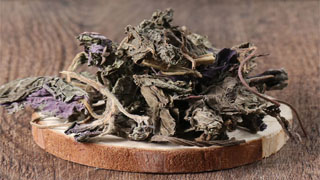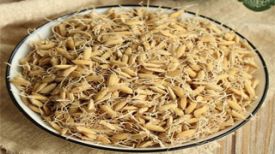
1. Aliases
Su Ye, seaweed, Su.2. Plant morphology
Annual herb, 30-200 centimeters tall. Has a special aroma. The stem is upright, multi branched, purple, greenish purple or green, obtuse quadrilateral, densely covered with long soft hairs. Leaves opposite; The petiole is 3-5 centimeters long, purple red or green, covered with long segmented hairs; The leaves are broadly ovate, ovate circular, or ovate triangular, measuring 4-13 centimeters in length and 2.5-10 centimeters in width. The apex is gradually pointed or protruding, sometimes forming a short tail shape. The base is circular or broadly wedge-shaped, and the edges have coarse serrations. Sometimes the serrations are deeper or shallowly split, with purple on both sides or only below. The upper and lower sides are sparsely pubescent, and the leaves are dense along the veins. There are fine oil gland spots below the leaves; 7-8 pairs of lateral veins, located slightly closer to the lower part and rising obliquely. The inflorescence is composed of two flowers, forming a false raceme on one side. It is terminal and axillary, and the inflorescence is densely covered with villous hairs; Bracts ovate, ovate triangular or lanceolate, entire, ciliate, with glandular dots on the outside and membranous margins; Pedicels 1-1.5 millimeters long, densely covered with pubescence; Calyx bell shaped, about 3 millimeters long, with 10 veins. The outer lower part is densely covered with long soft hairs and yellow glandular dots. The top has 5 teeth, 2 lips, and the upper lip is broad with 3 teeth and the lower lip has 2 teeth. When fruiting, it increases in size and the base is sac-shaped; Corolla lip shaped, 3-4 millimeters long, white or purplish red, with a hairy ring inside the corolla tube and soft hairs on the outside. The upper lip is slightly concave, and the lower lip is 3-lobed, with nearly circular lobes and larger middle lobes; Stamens 4, 2-strong, inserted in the middle of the corolla tube, rarely extending outside the corolla, anthers 2-chambered; The flower disc expands at the front; Pistil 1, ovary 4-lobed, style base attached, stigma 2-lobed; The flower disc expands at the front; Pistil 1, ovary 4-lobed, style base attached, stigma 2-lobed. Small nuts are nearly spherical, gray brown or brown in color, with a diameter of 1-1.3 millimeters and reticulated patterns. The calyx is about 10 millimeters long. The flowering period is from June to August, and the fruiting period is from July to September.
3. Origin distribution
Widely cultivated throughout the country.
4. Harvesting and processing
Harvest when the branches and leaves are lush in summer, remove impurities, and dry in the sun.
5. Characteristics of medicinal herbs
Perilla leaves are often wrinkled, curled, and broken. The intact leaves are flattened and oval in shape, measuring 6-14 centimeters in length and 3-11 centimeters in width. The apex is long pointed or acute, the base is wide wedge-shaped, and the edge has circular serrations; Both sides are dark green and sparsely fluffy; The petiole is 2.5-8 centimeters long and densely covered with white fur. Crisp texture, fragrant aroma, slightly spicy taste.
6. Nature, taste, and meridian tropism
Warm in nature and spicy in taste. Return to the lung meridian and spleen meridian.
7. Effect and function
Relieve external heat and dispel cold, promote Qi and stomach circulation. Xin Wen Jie Biao Yao belongs to the subcategory of Jie Biao Yao.
8. Clinical applications
Internal administration: decoction, 5-10 grams. External use: In moderation, apply by pounding, grinding and mixing, or wash with decoction. Used for cold and wind, coughing and vomiting, pregnancy vomiting, fish and crab poisoning.
9. Pharmacological research
Perilla leaves have sedative and weak antipyretic effects; Can cause inhibitory effects on excitatory membranes; Can promote the secretion of digestive juices and enhance gastrointestinal motility; It has the effects and effects of relieving cough, phlegm, and asthma on the respiratory system, and has a dual effect of hemostasis and anticoagulation on the blood system; Elevate blood sugar; Regulate the body's immune function and possess anti mutagenic ability; Anti microbial, with broad-spectrum antibacterial effects. It has a mild inhibitory effect on adenylate cyclase and a strong inhibitory effect on xanthine oxidase; Has significant antioxidant effects; It still has anti-inflammatory effects.
10. Chemical composition
Perilla leaves contain components such as perillaldehyde, perilla ketone, berberine, menthol, baicalin, New Zealand quercetin II, and quercetin.
11. Taboos for use
Patients with yin deficiency, qi deficiency, and warm diseases should take medication with caution.
12. Compatibility prescription
① Treating cold and fever: 4.5g of perilla leaves, Fangfeng, and Chuanxiong each, 3g of tangerine peel, and 1.8g of licorice. Add two slices of ginger and fry. (Su Ye Tang from "I Don't Know Medical Necessity")
② More than just treating typhoid fever: Take a handful of perilla, three liters of water, boil two liters, and drink a little. (Behind the Elbow)
③ Treatment of breast abscess swelling and pain: Take perilla decoction frequently and seal it with tamping. ("Famous Fang on the Sea")
④ To treat eczema and scabies: grind and apply the leaves of Dasu. (Puji Fang)
⑤ Treatment of falling and rushing injuries: Tame and apply perilla. The sores self heal. (Tan Yeweng Experimental Formula)
⑥ To treat snake cobra injuries: Crush perilla juice and drink it. (Qian Jin Yao Fang)
The content of the article is for clinical reference only. Non professionals in traditional Chinese medicine are not allowed to try medication.


